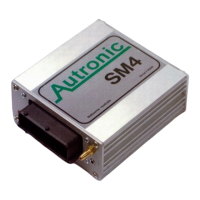Autronic turbo-charger anti-lag system uses a coordinated fuel and ignition control
strategy in conjunction with a large effective throttle opening to produce a substantial
reduction in turbo-charger "lag". The system is effective from a standing start, throughout
up & down shifts and when accelerating out of corners. The system can be used with a
large fixed throttle opening, or in conjunction- with electro-mechanical throttle by-pass
valve or a throttle "kicker" solenoid. The system incorporates an optional turbo-charger
cool-down function that ensures rapid cool-down prior to engine shutdown.
This anti-lag system allows the engine's large throttle opening or bypass to produce a
considerable amount of hot high velocity exhaust gas that sustains high turbo-charger
speed.
This is achieved with a higher than normal idle speed (2000 to 4000 RPM typ.). The cool-
down mode uses a different strategy to produce a large volume of cool exhaust gas for
rapid turbo cool-down and it simultaneously controls idle engine speed with the large
throttle opening required.
CAUTION
This anti-lag system, like all others, causes considerable heating of engine, exhaust
valves, exhaust manifold, turbo-charger and exhaust system. Consideration must be
given to the possibility of component damage or possible vehicle fire.
Set-up of the anti-lag system MUST NOT be attempted without monitoring EXHAUST
GAS TEMPERATURE (EGT) in the vicinity of the turbine wheel. Knowledge of the
maximum safe working temperature of the turbo-charger turbine is essential. A turbo
tacho and a pressure gauge to measure the turbo compressor outlet pressure are also
useful tools to assist in the setup of anti-lag.
!!!! IMPORTANT!!!!
1. Irrespective of the actual throttle opening used the ECU must be reset so
that the selected open is seen by the ECU as 0% open. Throttle limit
learning must be performed each time a new throttle stop setting is set.
2. Before attempting anti-lag set-up it is most important that correct fuel and
ignition calibration be achieved for "normal" engine operation.
Anti-lag ignition
Ignition retard from base ignition.
Throttle opening, ignition retard and the resulting anti-lag no-load RPM must be chosen
to produce the best compromise between excessive exhaust temperature and good anti-
lag action. More throttle requires greater ignition retard to control no-load throttle closed
RPM, and results in higher EGT. Anti-lag ignition timing for small capacity 4 valve central
spark plug combustion chamber engines should be in range -20 to -30 deg. For large
capacity 2 valve engines -2 to -20 deg should suffice. Ignition timing retard should be
maintained up to a MAP value as high as possible but must be eliminated before 1
atmosphere is reached to ensure adequate off-boost performance. Below anti-lag RPM
normal ignition timing should be restored so that engine torque increases with decreasing
RPM in order to stabilise RPM. Additional fuel during and-lag is often required to help
control EGT. A value between 10 and 20% extra is usually beneficial. The User defined
PWM table functions as the anti-lag ignition offset table 1% = 1 deg retard.

